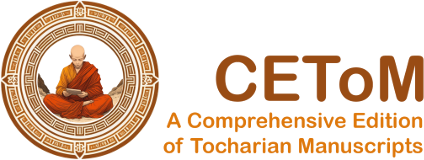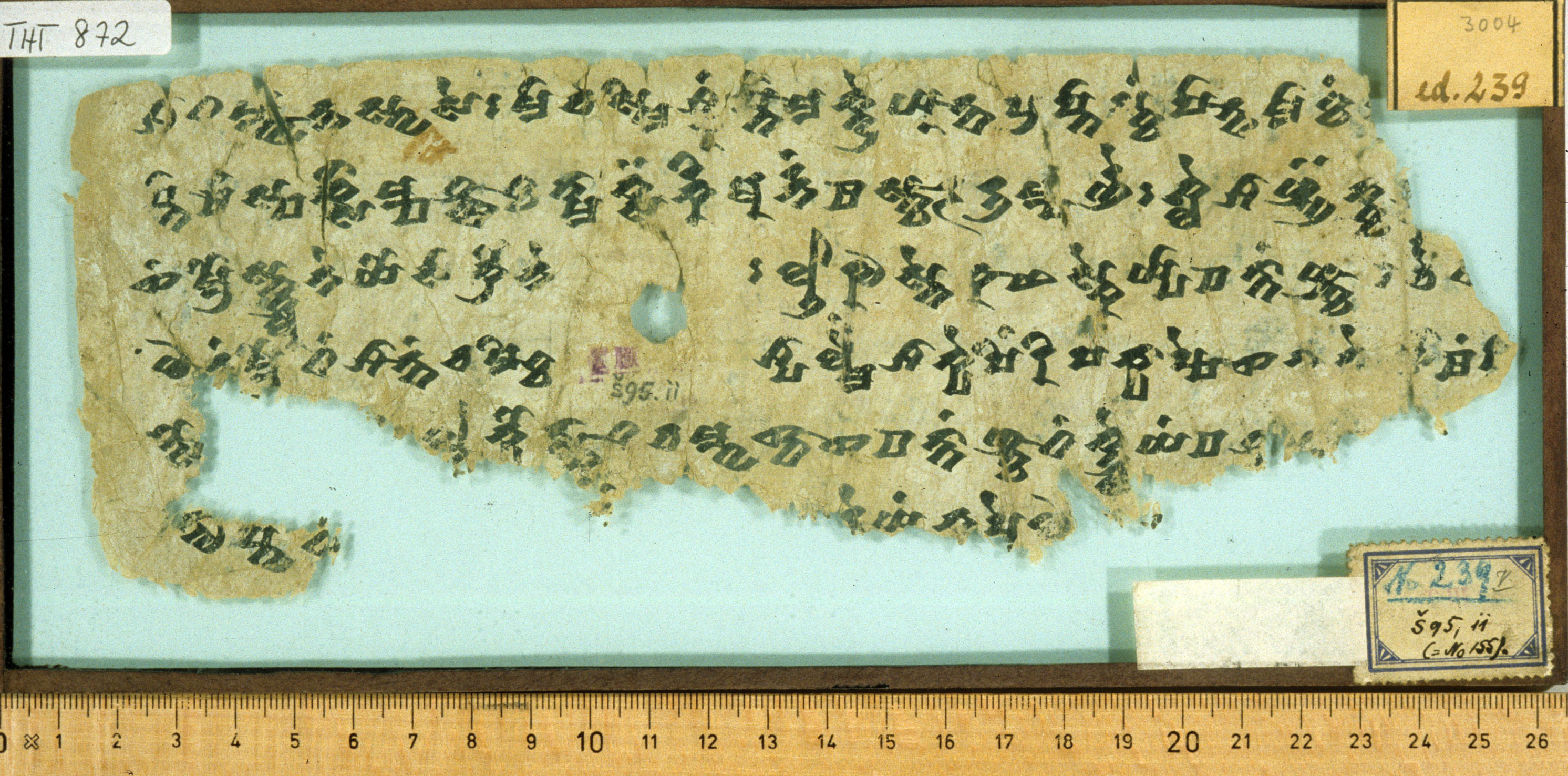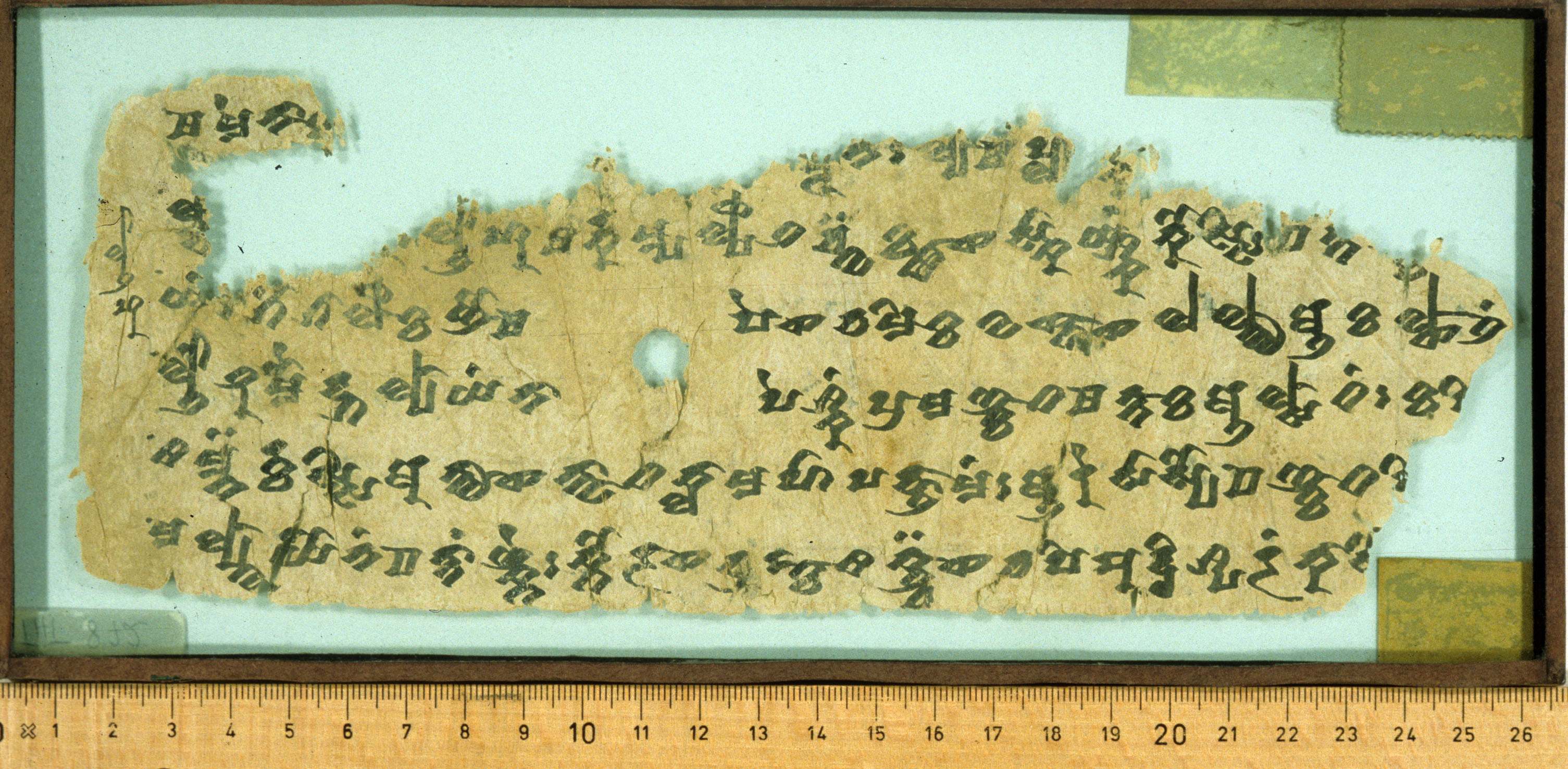A 239
| Known as: | A 239; THT 872 |
|---|---|
| Cite this page as: | Gerd Carling; Adrian Musitz (translation). "A 239". In A Comprehensive Edition of Tocharian Manuscripts (CEToM). Created and maintained by Melanie Malzahn, Martin Braun, Hannes A. Fellner, and Bernhard Koller. https://cetom.univie.ac.at/?m-a239 (accessed 08 Jul. 2025). |
Edition | |
| Editor: | Gerd Carling; Adrian Musitz (translation) |
Provenience | |
| Main find spot: | Shorchuk |
| Specific find spot: | Stadthöhle |
| Expedition code: | T III Š 95.11 |
| Collection: | Berlin Turfan Collection |
Language and Script | |
| Language: | TA |
| Script: | late |
Text contents | |
| Text genre: | Literary |
| Meter: | 4343 (4x) |
Object | |
| Manuscript: | MAV-β |
| Material: | ink on paper |
| Form: | Poṭhī |
| Number of lines: | 6 |
Images
Images from idp.bl.uk by courtesy of the International Dunhuang Project, the Berlin-Brandenburgische Akademie der Wissenschaften, and the Staatsbibliothek zu Berlin – Orientabteilung.
Transliteration
| a1 | śā ta mwa¯ ¯nt swa se : mā ce smi śkaṃ ṣtā¯ ¯m kwre yu¯ ¯nt pra ṣtā [p]kaṃ ṣā¯ ¯nt mā kaṃ /// |
|---|---|
| a2 | ṣtā¯ ¯m spa rksā mpa ltsa¯ ¯k tmā ksä rki a rnaṃ ma ska¯ ¯r u mpa rñe : kle śā ññä kka /// |
| a3 | s̝a mro skulu ne yo sā kro ne : 100 5 sne ka¯ ¯ś ske ypā pa ttāṃ ñka¯ ¯t ce [sa] /// |
| a4 | o [nt]aṃ mro saṃ śā¯ ¯nt ca mi¯ ¯k śpā lmeṃ śā kye ṣiṃ ri ṣa kyā pṣe¯ ¯s̝ na n·e [ño]¯ ¯m /// |
| a5 | tso – – – – l[ta] kyo tskā¯ ¯t ca mwa s̝ta¯ ¯s̝ pa ttāṃ ñka¯ ¯t kule yaṃ pa l·· /// |
| a6 | ntu ṣw· [ta] – – – – – – – – – re yaṃ k· pre o /// |
| lf | 100 8 |
| b1 | ma me nā[¯] [¯k] – – – – – – – – – ·ṣū n· : ly·¯ ¯m plya [s]k· /// |
| b2 | l[tsa] – – – : 100 8 ma rka mpa lṣiṃ la cwä kna¯ ¯s̝ skā yśkaṃ ko ssi pa tt·· ka /// |
| b3 | yaṃ : go gā li¯ ¯k ño¯ ¯m ṣe¯ ¯s̝ ca mi¯ ¯k wa s̝ta¯ ¯s̝ la lntu ā ka ls̝a¯ ¯l /// |
| b4 | 100 9 mau dga lyā yaṃ nā pe śkaṃ pra¯ ¯m ñka¯ ¯t ma tta¯ ¯k ā lsā taṃ : ka [ṣ]·i /// |
| b5 | sa mnä rka ssi a ntu¯ ¯s̝ nwā¯ ¯t klā ma hā pa dū¯ ¯m : ā re sā syo pa ñka¯ ¯t [ṣ]i /// |
| b6 | ma lywā yo naṃ pa ttāṃ ñkte : kto ra¯ ¯s̝ cra ṅka¯ ¯s kucä¯ ¯s̝ ca ṣi bu ddhi śpa raṃ kā s·o /// |
Transcription
| lf | 100-8 |
| 104c | a1 śātäm ; want swase : |
|---|---|
| 104d | mā cesmi śkaṃ ; ṣtām-kwreyunt ; praṣtā pkäṃṣānt ; mā käṃ(ṣānt) |
| 105a | /// 13σ a2 ṣtām {:} |
| 105b | spärksā-m pältsäk ; tmā-k särki ; arnaṃ mäskär ; umparñe : |
| 105c | kleśāññäk kä /// ; 10σ |
| 105d | 7σ a3 ṣ{†ä} ; mroskuluneyo ; sākrone : 100-5 |
| 106a | sne kaś ske ypā ; pättāṃñkät ; cesä /// 5σ |
| 106b | 9σ a4 ontaṃ ; mrosäṃśānt {:} |
| 106c | cami-k śpālmeṃ ; śākyeṣiṃ ; riṣakyāp ṣeṣ ; nan(d)e ñom |
| 106d | /// 14σ |
| 107a | a5 tso – – – ; (spa)ltäkyo ; tskāt cam waṣtäṣ ; pättāṃñkät {:} |
| 107b | kuleyaṃ päl·· /// 11σ |
| a6 | ntuṣ w· tä – – – – – – – – (ña)reyaṃ k(u)pre o(ntaṃ) /// |
|---|---|
| b1 | m{†ä} menāk – – – – – – – – – ·ṣūn· : |
| 108c | ly(ä)m plyask· /// 12σ |
|---|---|
| 108d | 10σ b2ltsä ; – – – : 100-8 |
| 109a | märkampalṣiṃ ; läc wäknäṣ ; skāy śkaṃ kossi ; pätt(āṃñ)kä /// |
| 109b | 11σ (nare)b3yaṃ : |
| 109c | gogālik ñom ; ṣeṣ cami-k ; waṣtäṣ lalntu ; ākälṣäl |
| 109d | /// 14σ b4100-9 |
| 110a | maudgalyāyaṃ;nā pe śkaṃ ; pram ñkät mättak ; ālsāt-äṃ : |
| 110b | käṣ(ṣ)i /// 12σ |
| 110c | 3σ b5 säm ; närkässi ; antuṣ nwāt klā ; mahāpadūm : |
| 110d | āresāsyo ; pä{ttāṃ}ñkät ; ṣi /// 6σ |
| 111a | 7σ b6 ; malywā yonaṃ ; pättāṃñkte : |
| 111b | ktoräṣ craṅkäs ; kucäṣ caṣi ; buddhiśparäṃ ; kās(w)o(ne) /// |
Translation
| a1 | ... wind and rain. and for them the canes did not ripen at the [right] time they were not brought about. |
|---|---|
| a1+ | ... tree... |
| a2 | They lost their minds. Thereafter, they became bad in appearance. The Kleśas... |
| a3 | ... blissfulness through aversion... The Buddha would make effort without number... them... |
| a4 | ... they would feel aversion... This excellent sage of the Śākyas had (a brother) named Nanda. |
| a5 | ... with the Buddha pulled him out of his home. ... woman... |
| a6 | (after)wards (he) l(e)d... in hell... if... |
| b1 | ... similar... ... meditated... |
| b2 | He strayed from the lawful way and attempted to kill the Buddha... |
| b2+ | ... in hell.. |
| b3 | He had a student named Gogālik, a wandering monk. |
| b4 | ... the god Brahman himself kept him away from (?) Maudgalyāyana... The teacher... |
| b5 | ... he then intended to keep away... He fell into the Mahāpadma-hell. The Buddha... by plowmen... |
| b6 | ... was crushing in the footprint of the Buddha... Having sowed... he said: Why... his Buddhahood... virtue... |
Other
| a1 | Und nicht wurden ihnen die Baumfrüchte zur [rechten] Zeit reif [und] kamen nicht zustande. (Schmidt 1974: 129, 135) |
|---|---|
| a3+ | Zahllos machte der Buddha Anstrengung, die[se] Wesen zur Entsagung zu bringen, in langer Zeit (in) [jedem] einzelnen (Augenblick). [Aber] sie entsagten eben (nicht). (Schmidt 1974: 161-2) |
| a5 | Mit großer Mühe [und] Anstrengung zog ihn der Buddha aus dem Hause. [Da] er [sein] Denken an eine Frau gehängt [hatte], duldete er [es nämlich] nicht, zu entsagen. (Schmidt 1974: 470) |
| a6 | Alsdann führte er [scil. der Buddha] (ihn zu den Göttern). [Aber erst] als er ihn von da in die Hölle führte, entsagte er. (Schmidt 1974: 386) |
Commentary
Remarks
| Transcription and references have been transferred from the "Text and Reference Database of the Tocharian A Language" (Gerd Carling Lund University) (funded by the Bank of Sweden Tercentenary Foundation and SCAS). | |
| Transcription and translation are based on Carling et al. 2009. |
Parallel texts
| A 222 |
References
Online access
Miscellaneous
Edition
Sieg and Siegling 1921: 120; Sieg and Siegling 1921 p. 120
Translations
Hackstein 1995: a1 (88f), a5 (141), b4 (214); Schmidt 1974: a1 (129), a1 (135), a1 (129, 135), a3 a4 (161f), a3 a4 (161-2), a5 (470), a6 (386), b1 (404 n.6), b4 (500 n.5), b5 (500 n.7); Thomas 1954: b2 (719); Thomas 1957: a3 a4 (14, 62), a4 (34), a4 a5 a6 (104), a6 (14, 234), b1 (205), b1 b2 b3 (104), b3 (34), b4 b5 (105 and n.2); Thomas 1969: b4 (237); Thomas 1972: a5 (461); Thomas 1993: a5 (209)
Bibliography
Carling, Gerd, Georges-Jean Pinault, and Werner Winter. 2009. A dictionary and thesaurus of Tocharian A. Volume 1: Letters a-j. Wiesbaden: Harrassowitz.
Hackstein, Olav. 1995. Untersuchungen zu den sigmatischen Präsensstammbildungen des Tocharischen. HS Erg.-Heft 38. Göttingen: Vandenhoeck & Ruprecht.
“The International Dunhuang Project: The Silk Road Online.” n.d. http://idp.bl.uk.
Schmidt, Klaus T. 1974. “Die Gebrauchsweisen des Mediums im Tocharischen.” PhD, Universität Göttingen.
Sieg, Emil, and Wilhelm Siegling. 1921. Tocharische Sprachreste, I. Band. Die Texte. A. Transcription. Berlin/Leipzig: de Gruyter.
Sieg, Emil, and Wilhelm Siegling. 1921. Tocharische Sprachreste, I. Band. Die Texte. A. Transcription. Personal annotated copy of Wilhelm Siegling. Scanned by Douglas Q. Adams with the technical assistance of Michael Tarabulski and Kevin Dobbins. Berlin/Leipzig: de Gruyter.
Thomas, Werner. 1954. “Die Infinitive im Tocharischen.” In Asiatica. Festschrift Friedrich Weller. Zum 65. Geburtstag, gewidmet von seinen Freunden, Kollegen und Schülern, edited by Johannes Schubert and Ulrich Schneider, 701–64. Leipzig: Harrassowitz.
Thomas, Werner. 1957. Der Gebrauch der Vergangenheitstempora im Tocharischen. Wiesbaden: Harrassowitz.
Thomas, Werner. 1969. “Bemerkungen zum Gebrauch von toch. A ptāñkät [B pañäkte, pudñäkte], A koṃ [B kauṃ]: A koṃñkät [B kauṃñäkte] usw.” Orbis 18: 235–68.
Thomas, Werner. 1972. “Zweigliedrige Wortverbindungen im Tocharischen.” Orbis 21: 429–70.
Thomas, Werner. 1993. Parallele Texte im Tocharischen und ihre Bewertung. Vol. 5. SbWGF, XXX. Stuttgart: Steiner.
Gippert, Jost, Katharina Kupfer, Christiane Schaefer, and Tatsushi Tamai. n.d. “Thesaurus Indogermanischer Text- und Sprachmaterialien (TITUS): Tocharian Manuscripts from the Berlin Turfan Collection.” http://titus.fkidg1.uni-frankfurt.de/texte/tocharic/thtframe.htm.




